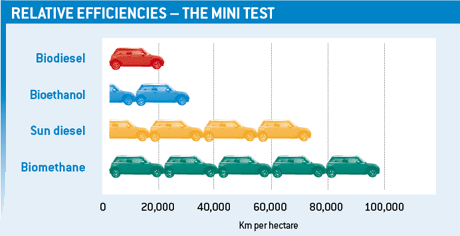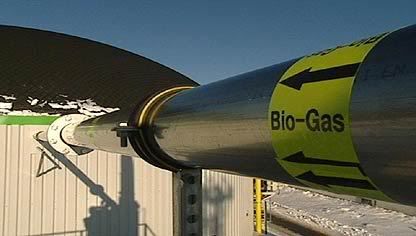Banana Methane Powered Cars, Pig Poo Power And Other Uses For Biogas
Posted by Big Gav in biogas
 Powering transport using liquid petroleum gas, compressed natural gas or fuel produced by gas-to-liquids processes are options that have received varying amounts of attention in recent years as the oil price climbs ever higher. While shifting dependence from one fossil fuel to another doesn't make a great deal of sense when you take peak oil and gas into account, there is a renewable option for producing gas - biogas.
Powering transport using liquid petroleum gas, compressed natural gas or fuel produced by gas-to-liquids processes are options that have received varying amounts of attention in recent years as the oil price climbs ever higher. While shifting dependence from one fossil fuel to another doesn't make a great deal of sense when you take peak oil and gas into account, there is a renewable option for producing gas - biogas.
One recent example of biogas use in Australia is a pilot project by horticulture company Growcom to convert banana waste into biomethane, which will then be used as fuel by cars converted to use compressed natural gas and by a generator for electricity production.
The processing plant uses an anaerobic digester - in trials, the banana waste produced maximum yields of 398 litres of methane per kg of dry banana. With this yield, 1 ton of bananas per day can generate around 7.5 kW of electricity - enough to supply six to eight modern households.
According to research done at the University of Queensland by Associate Professor Bill Clarke, over 310,000 tonnes of bananas are grown in Australia each year (250,000 tonnes in FNQ). Approximately 30% of the bananas are rejected at the packing stage for quality reasons. Gloablly, around 70 million tonnes of bananas are produced each year, 20% of which are traded.
Growcom board member Keith Noble says, "An over-riding principle of the project has been to use locally available materials and expertise wherever possible. The system must also integrate with existing farm practices. If on-farm digesters are to have a commercial future they must add to farm efficiency and be simple to operate."

Given the volume of bananas required to produce the gas, banana power will only ever be a niche solution (something the people involved readily admit), but it is an example of how waste streams can be used to produce biogas - which has the important benefit of not diverting food (or arable land) to fuel production - one of the major criticisms of present day biofuels.
An important additional benefit is that methane is a potent greenhouse gas, and thus capturing it and burning it helps from a global warming point of view.
Of course, Banana waste is just one type of agricultural byproduct that can be diverted to produce biogas - there are a wide variety of other byproducts from farming and the food industry that can be captured and digested in a similar way (wood chips being another example).
Pig Poo Power
 Another niche source of biogas that has considered in Australia is from animal manure - specifically pig poo. This seems to be part of a worldwide trend, with countries as far afield as Thailand and South Korea also harnessing the foul odours and putting them to good use.
Another niche source of biogas that has considered in Australia is from animal manure - specifically pig poo. This seems to be part of a worldwide trend, with countries as far afield as Thailand and South Korea also harnessing the foul odours and putting them to good use.Famed Kleiner Perkins Caufield and Byers venture capitalist John Doerr is also getting in on the act, looking at pig farms in California's Central Valley for opportunities.
Pig's aren't the only animals producing large amounts of ordure that could be used for biogas production - other animals producing copious quantities of potential feedstock include cows (which could help solve another problem - burning mountains of cattle manure), dogs, chickens, turkeys (whose output is being burnt directly in biomass power generation facilities in the US, which has received criticism for both pollution and for burning material that would be of use for fertiliser) and zoo animals.
It isn't just the animal world that is capable of providing fuel of course, people can too. A Rwandan prison uses waste from the inmates to help power the prison.
 An Indian company called Sintex is even marketing an at-home biogas digester, with hopes of solving India's energy and sanitation problems in one hit. These plans have the enthusiastic backing of the WTO (World Toilet Organisation). A one-cubic-meter digester (initially filled with cow dung to provide the bacteria required) can convert the waste from a four-person family into enough gas to cook all its meals and provide sludge for fertilizer for around $425 - paying for itself in energy savings in less than two years.
An Indian company called Sintex is even marketing an at-home biogas digester, with hopes of solving India's energy and sanitation problems in one hit. These plans have the enthusiastic backing of the WTO (World Toilet Organisation). A one-cubic-meter digester (initially filled with cow dung to provide the bacteria required) can convert the waste from a four-person family into enough gas to cook all its meals and provide sludge for fertilizer for around $425 - paying for itself in energy savings in less than two years. Similar schemes are in use in many other developing nations (an Energy Blog commenter once referred to the developing world as "one large zone of 'stranded biogas'".
Landfill Gas
Another widespread use of biogas is capturing the gas produced in landfills for power generation - Australia already has a number of plants in use, and a large number of developments are underway in the US capable of generating hundreds of megawatts of power, with an estimated 700 sites capable of being used for this purpose.
One heavy user of landfill gas is General Motors, which has reduced its consumption of natural gas by around 25% since 2000 by replacing it with gas from landfills. The University of New Hampshire is getting over 8% of its energy from landfill gas. The city of Sao Paulo in Brazil has a 23 MW landfill gas plant in operation.
Biogas In Europe
Europe seems to be the leader in the production and use of biogas.
UK studies have shown that biogas is much cleaner and more efficient than biofuels for use in transport - and also allows farmers to become energy generators rather than just commodity producers.
According to an EU well-to-wheel study of more than 70 different (fossil and renewable) fuels and energy paths, biogas is the cleanest and most climate-neutral transport fuel of all.
Some examples of biogas use in Europe include:
* Austrian drivers can fill up their CNG cars using biogas made from grass.
* Denmark has more than 50 biogas plants in operation.
* The Netherlands is generating biogas from sewage treatment plants and feeding it into the gas grid and to fuel cars.
* Sweden is producing biogas from wastewater treatment plants and and using it to generate power and to fuel buses and trains.
* Germany is producing biogas from maize and using it in combined-heat-and-power plants (the French have developed a giant maize variety specifically for biogas production).
The German government is considering feeding biogas into the country's natural gas network (ironically, the main obstacle to this has been that biogas is too good for the network - exceeding Germany's upper limit on gas heating value, something the German Greens and farming lobby are trying to have fixed).
According to the government, locally produced biogas could supply up to 10 percent of Germany's total gas consumption by 2030. Germany is the largest producer of biogas in Europe, and biogas is Germany's fastest growing renewable energy sector.
One controversial study last year claimed that the EU could produce enough biogas to replace all natural gas imports from Russia by 2020, which would change Europe's energy security outlook considerably if it proves to be correct. The main findings of the study were:
* Europe's potential for the sustainable production of biomethane is 500 billion cubic meters of natural gas equivalent (17.7 trillion cubic feet) per year. This is roughly the total amount of natural gas currently consumed by the entire European Union.
* The entire EU's natural gas needs for the the medium-term future (2020) can be met by biogas; all imports from Russia can be replaced, while the excess can substitute petroleum and coal.
* The production of 500 billion cubic meters of biogas, fed into the grid, will result in a reduction of 15% of Europe's CO2 emissions. The Kyoto protocol demands a reduction of 10%.
* An efficient biogas-feed-in strategy will be build around the concept of 'biogas corridors': such corridors consist of biomass plantations established alongside the pipelines, so that the green gas can be fed into Europe's main natural gas grid without the need for new pipelines and infrastructures.
* A Europe-wide biogas-feed-in strategy will result in the creation of 2.7 million new jobs within the EU. Employment will be generated mainly in agriculture, in the manufacture, construction and management of biogas plants and biogas purification plants.
These sorts of plans will raise the usual questions about the wisdom of "fermenting the food supply" and the like, so at this point it is worth taking these claims with a grain of salt.
One company leading the way in Germany is Schmack Biogas, who are piloting feeding biogas into the grid and claim their super maize crop "reduces the land needed to grow feedstock by up to a third" and "restore degraded land and increase its fertility" - all of which sounds very nice, if true.
A related venture is the Combined power Plant idea being promoted by the University of Kassel, Enercon, SolarWorld and Schmack. This proposed plant "links and controls 36 wind, solar, biomass and hydropower installations spread throughout German", making it the distributed equivalent of a large conventional power plant. The plant uses biogas and hydro power to even out supply when the wind and solar components are generating at reduced capacity.











